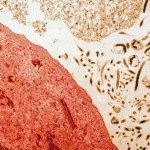Lien vers Pubmed [PMID] – 39625987
Lien DOI – 10.1371/journal.ppat.1012715
PLoS Pathog 2024 Dec; 20(12): e1012715
Several Old World and New World Mammarenavirus are responsible for hemorrhagic fever in humans. These enveloped viruses have a bi-segmented ambisense RNA genome that encodes four proteins. All Mammarenavirus identified to date share a common dependency on myristoylation: the addition of the C14 myristic acid on the N-terminal G2 residue on two of their proteins. The myristoylation of the Z matrix protein is required for viral particle budding, while the myristoylation of the signal peptide to the envelope glycoproteins is important for the entry mechanism. Using Mopeia virus as a model, we characterized the interaction of the Z matrix protein with the N-Myristoyltransferases (NMT) 1 and 2, the two enzymes responsible for myristoylation in mammals. While both enzymes were capable to interact with Z, we showed that only NMT1 was important for the production of viral progeny, the endogenous expression of NMT2 being insufficient to make up for NMT1 in its absence. Using the high affinity inhibitors of NMTs, IMP1088 and DDD85646, we demonstrated a strong, dose dependent and specific inhibition at the nanomolar range for all Mammarenavirus tested, including the highly pathogenic Lassa, Machupo, Junin and Lujo viruses. Mechanistically, IMP1088 and DDD85646 blocked the interaction between Z and both NMTs, preventing myristoylation and further viral particle formation, egress and spread. Unexpectedly, we found that the matrix protein devoid of myristate, despite being fully translated, did not accumulate as the other viral proteins in infected cells but was instead degraded in a proteasome- and autophagy-independent manner. These molecules represent a new broad-spectrum class of inhibitors against Mammarenavirus.

